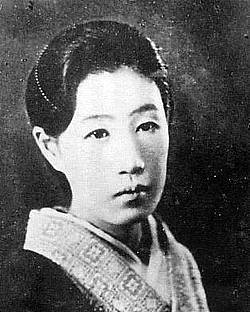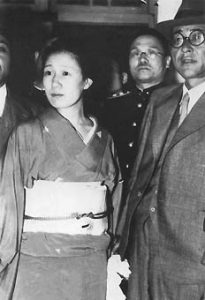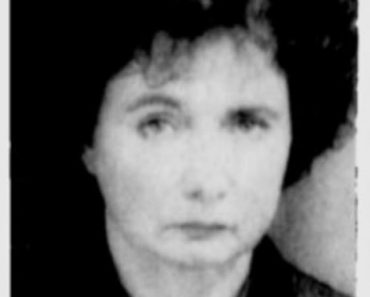Sada Abe | Murderer

Sada Abe
Born: 05-28-1905
Murder by Erotica Asphyxiation
Japanese Female Murderer
Crime Spree: May 18, 1936
Death: Sometime After 1971
Sada Abe was born in 1905. Her mother doted on her youngest child and let her do as she wished. She encouraged Sada to take lessons in singing and in playing the shamisen, both activities which, at the time, were more closely associated with geisha and prostitutes than with classical artistic endeavor. Geisha’s were considered glamorous celebrities, and Sada Abe herself followed the image by skipping school for these lessons, and wearing stylish make-up.
As family problems over her siblings, sister Teruko and brother Shintaro, became more pressing, Sada Abe was often sent out of the house alone. She soon fell in with a group of similarly independent teenagers.
Sada Abe
At the age of 15, during one of these outings, Sada Abe was raped by one of her acquaintances and, even though her parents defended and supported her, she became a difficult teenager. As she became more irresponsible and uncontrollable, her parents sold her to a geisha house in Yokohama in 1922, hoping to find her a place in society with some direction. Toku Abe, Sada’s oldest sister, testified that Sada Abe wished to become a geisha. Sada herself, however, claimed that her father made her a geisha as punishment for her promiscuity.
Abe’s encounter with the geisha world proved frustrating and disappointing. To become a true star among geisha required apprenticeship from childhood with years spent studying arts and music. Sada Abe wound up a low-ranking geisha, in which her main duties were to provide sex. She worked for five years in this capacity, and eventually contracted syphilis. Since this meant she would be required to undergo regular examinations, like a legally licensed prostitute, Sada decided to enter that better-paying profession.
Early 1930’s
Sada Abe began work as a prostitute in Osaka’s famous Tobita brothel district, but soon gained a reputation as a trouble-maker. She stole money from clients and attempted to leave the brothel several times, but was tracked down by the well-organized legal prostitution system. After two years, she eventually succeeded in escaping the licensed prostitution system, and began working as a waitress. However, not satisfied with the wages, she was soon working as a prostitute again, though now unlicensed. She began working in Osaka’s unlicensed brothels in 1932.
Sada’s mother died in January 1933, and Abe went to Tokyo to visit her father and her mother’s grave. She entered into the prostitution market in Tokyo and became a mistress there for the first time. When her father became seriously ill in January of 1934, Sada Abe nursed him for ten days until his death.
In October 1934 Sada Abe was arrested in a police raid on the unlicensed brothel at which she was working. Kinnosuke Kasahara, a well-connected friend of the brothel owner, arranged to have the women released. He was attracted to Sada Abe, and, finding that she had no debts, and with Abe’s agreement, made her his mistress. Kasahara set up a house for Sada on December 20, 1934, and provided her with money. In his deposition to the police, he remembered, “She was really strong, a real powerful one. Even though I am pretty jaded, she was enough to astound me. She wasn’t satisfied unless we did it two, three, or four times a night. To her, it was unacceptable unless I had my hand on her private parts all night long. At first it was great, but after a couple of weeks I got a little exhausted.” When Sada Abe suggested that Kasahara leave his wife to marry her, he refused. She then asked Kasahara to let her take a lover, which he also refused to do. After that, their relationship ended, and to escape him Sada left for Nagoya.
Sada Abe
Kasahara ended his testimony with an angry remark about Sada Abe, “She is a slut and a whore. And as what she has done makes clear, she is a woman whom men should fear.” Likewise, Sada Abe remembered Kasahara in less than flattering terms, saying, “He didn’t love me and treated me like an animal. He was the kind of scum who would then plead with me when I said that we should break up.”
In Nagoya in 1935, again intending to leave the sex industry, Sada began working as a maid at a restaurant. She soon became romantically involved with a customer at the restaurant, Goro Omiya, a professor and banker who aspired to become a member of the Diet of Japan. Knowing that the restaurant would not tolerate a maid having sexual relations with clients, and bored with Nagoya, she returned to Tokyo in June. Omiya met Sada Abe in Tokyo, and, finding that she had contracted syphilis, paid for her stay in a hot springs resort in Kusatsu from November until January 1936. In January, Omiya suggested that Sada Abe could become financially independent by opening a small restaurant, and recommended that she start work in an apprentice position in such a business.
Kichizo Ishida
Back in Tokyo, Sada Abe began work as an apprentice at the Yoshidaya on February 1, 1936. The owner of this establishment, Kichizo Ishida, 42 at the time, had worked his way up in business, starting as an apprentice at an eel restaurant. He had opened the Yoshidaya in Tokyo’s Nakano neighborhood in 1920. When Sada Abe joined his restaurant, Ishida was known as a womanizer who did little in the way of running the restaurant, which was managed mostly by his wife.
Not long after she began work at Yoshidaya, Ishida began making advances towards Sada Abe. Omiya had never satisfied Abe sexually, and she gave in to Ishida. In mid-April, Ishida and Sada initiated their sexual relationship in the restaurant, to the accompaniment of a romantic ballad sung by one of the restaurant’s geisha’s.
On April 23, 1936 Sada Abe and Ishida met for a pre-arranged sexual encounter at a tea house, or machiai – the contemporary equivalent of a love hotel – in the Shibuya neighborhood. Planning only a short ‘fling’, the couple remained in bed for four days.
On the night of April 27, 1936, they moved to another tea house in the distant neighborhood of Futako Tamagawa. Here they continued to drink and have sex, sometimes with the accompaniment of a geisha’s singing. They would continue even as maids entered the room to serve sake.
Sada Abe
They next moved their marathon love-making bout to the Ogu neighborhood. Ishida did not return to the restaurant until the morning of May 8, 1936. Of Ishida, Sada Abe later said, “It is hard to say exactly what was so good about Ishida. But it was impossible to say anything bad about his looks, his attitude, his skill as a lover, the way he expressed his feelings. I had never met such a sexy man.”
After they separated, Sada Abe became agitated and began drinking excessively. She claimed that with Ishida she knew love for the first time in her life, and the thought that Ishida was back with his wife made her jealous. Over a week before the murder, Sada Abe began considering the act.
On May 9, 1936, she attended a play in which a geisha attacks her lover with a large knife. After seeing this, Abe decided to threaten Ishida with a knife at their next meeting. On May 11, 1936, she pawned some of her clothing and used the money to buy some sushi and a kitchen knife. Sada Abe later described meeting Ishida that night, “I pulled the kitchen knife out of my bag and threatened him as had been done in the play I had seen, saying, ‘Kichi, you wore that kimono just to please one of your favorite customers. You bastard, I’ll kill you for that.’ Ishida was startled and drew away a little, but he seemed delighted with it all…”
The Sada Abe Incident

Ishida and Sada Abe returned to Ogu, where they remained until his death. During their love-making this time, Abe put the knife to the base of Ishida’s penis, and said she would make sure he would never play around with another woman. Ishida laughed at this. Two nights into this bout of sex, Sada Abe began choking Ishida, and he told her to continue, saying that this increased his pleasure. She had him do it to her as well.
On the evening of May 16, 1936, Sada used her obi sash to cut off Ishida’s breathing during orgasm, and they both enjoyed it. They repeated this for two more hours. Once Sada Abe stopped the strangulation, Ishida’s face became distorted, and would not return to its normal appearance. Ishida took 30 tablets of a sedative called Calmotin to try to soothe his pain. According to Abe, as Ishida started to doze, he told her, “You’ll put the cord around my neck and squeeze it again while I’m sleeping, won’t you…? If you start to strangle me, don’t stop, because it is so painful afterward.” Sada Abe commented that she wondered if he had wanted her to kill him, but on reflection decided he must have been joking.
About 2 a.m. on the morning of May 18, 1936, as Ishida was asleep, Sada Abe wrapped her sash twice around his neck and strangled him to death. She later told police, “After I had killed Ishida I felt totally at ease, as though a heavy burden had been lifted from my shoulders, and I felt a sense of clarity.” After lying with Ishida’s body for a few hours, she next severed his genitalia with the kitchen knife, wrapped them in a magazine cover, and kept them until her arrest three days later. With the blood she wrote Sada, Kichi Futari-kiri (“Sada, Kichi together”) on Ishida’s left thigh, and on a bed sheet. She then carved 定 (“Sada”, the character for her name) into his left arm. After putting on Ishida’s underwear, she left the inn at about 8 a.m., telling the staff not to disturb Ishida. When asked why she had severed Ishida’s genitalia, Sada Abe replied, “Because I couldn’t take his head or body with me. I wanted to take the part of him that brought back to me the most vivid memories.”
After leaving the inn, Sada Abe met Goro Omiya. She repeatedly apologized to him, but Omiya, unaware of the murder, assumed that she was apologizing for having taken another lover. Abe’s apologies were for the damage to his political career that she knew his association with her was bound to cause. On May 19, 1936, the newspapers picked up the story. Omiya’s career was ruined, and Abe’s life was under intense public scrutiny from that point onward.
Abe Sada Panic
The story immediately became a national sensation, and the ensuing frenzy over her search was called “Abe Sada Panic”. Police received reports of sightings of Sada Abe from various cities, and one false sighting nearly caused a stampede in the Ginza, resulting in a large traffic jam. In a reference to the recent failed coup in Tokyo, the Ni Ni-Roku Incident (“2-26” or “February 26”), the crime was satirically dubbed the “Go Ichi-Hachi” Incident (“5-18” or “May 18”).
On May 19, 1936, Sada Abe went shopping and saw a movie. She stayed in an inn in Shinagawa on May 20, where she had a massage and drank three bottles of beer. She spent the day writing farewell letters to Omiya, a friend, and Ishida. She planned to commit suicide one week after the murder, and practiced necrophilia. “I felt attached to Ishida’s penis and thought that only after taking leave from it quietly could I then die. I unwrapped the paper holding them and gazed at his penis and scrotum. I put his penis in my mouth and even tried to insert it inside me… It didn’t work however though I kept trying and trying. Then, I decided that I would flee to Osaka, staying with Ishida’s penis all the while. In the end, I would jump from a cliff on Mount Ikoma while holding on to his penis.”
At 4:00 in the afternoon, police detectives, suspicious of the alias under which Sada Abe had registered, came to her room. “Don’t be so formal,” she told them, “You’re looking for Sada Abe, right? Well that’s me. I am Sada Abe.” When the police were not convinced, she displayed Ishida’s genitalia as proof.
The Arrest of Sada Abe
Sada Abe was arrested and interrogated over eight sessions. The interrogating officer was struck by Abe’s demeanor when asked why she had killed Ishida. “Immediately she became excited and her eyes sparkled in a strange way.” Her answer was: “I loved him so much, I wanted him all to myself. But since we were not husband and wife, as long as he lived he could be embraced by other women. I knew that if I killed him no other woman could ever touch him again, so I killed him…..” In attempting to explain what distinguished Abe’s case from over a dozen other similar cases in Japan, William Johnston suggests that it is this answer which captured the imagination of the nation. “She had killed not out of jealousy but out of love.” Mark Schreiber notes that the Sada Abe incident occurred at a time when the Japanese media were preoccupied with extreme political and military troubles, including the Ni Ni Roku incident and a looming full-scale war in China. He suggests that a sensationalistic sex scandal such as this served as a welcome national release from the disturbing events of the time. The incident also struck a chord with the ero-guro-nansensu (“erotic-grotesque-nonsense”) style popular at the time, and the Sada Abe Incident came to represent that genre for years to come.
When the details of the crime were made public, rumors began to circulate that Ishida’s penis was of extraordinary size; however, the police officer who interrogated Sada Abe after her arrest denied this, saying, “Ishida’s was just average. [Abe] told me, ‘Size doesn’t make a man in bed. Technique and his desire to please me were what I liked about Ishida.'” After her arrest, Ishida’s penis and testicles were moved to Tokyo University Medical School’s pathology museum. They were put on public display soon after the end of World War II, but have since disappeared.
The Conviction of Sada Abe
The first day of Abe’s trial was November 25, 1936, and by 5 a.m. crowds were already gathering to attend. The judge presiding over the trial admitted to being sexually aroused by some of the details involved in the case, yet made sure that the trial was held with the utmost seriousness. Abe’s statement before receiving sentencing began, “The thing I regret most about this incident is that I have come to be misunderstood as some kind of sexual pervert. There had never been a man in my life like Ishida. There were men I liked, and with whom I slept without accepting money, but none made me feel the way I did toward him.”
On December 21, 1936 Sada Abe was convicted of murder in the second degree and mutilation of a corpse. Though the prosecution demanded ten years, and Sada Abe claimed that she desired the death penalty, she was in fact sentenced to just six years in prison. She was confined in Tochigi women’s penitentiary, where she was prisoner No. 11.
Abe’s sentence was commuted on November 10, 1940, on the occasion of the 2,600th anniversary celebrations of the mythical founding of Japan, when Emperor Jimmu came to the throne. She was released, exactly five years after the murder, on May 17, 1941.
source: murderpedia | Wikipedia
This site contains affiliate links. We may, at no cost to you, receive a commission for purchases made through these links





























































